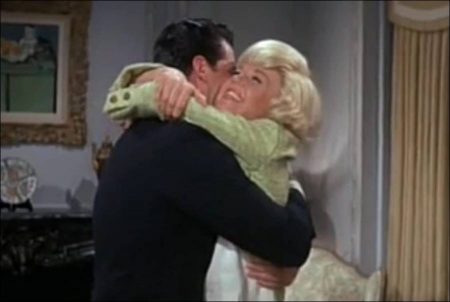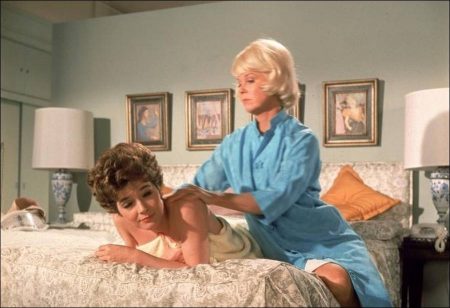Taglines: It’s sheer bedlam from morning ’til night.
Move Over, Darling movie storyline. Three years into their loving marriage with two infant daughters at home in Los Angeles, Nicholas Arden and Ellen Wagstaff Arden are on a plane that goes down in the South Pacific. Although most passengers manage to survive the incident, Ellen presumably perishes when she is swept off the lifeboat she is on. Her body is not recovered. Fast forward five years.
Nicky, wanting now to move on with his life, has Ellen declared legally dead. Part of that moving on includes getting remarried, this time to a young woman named Bianca Steele, who, for their honeymoon, he plans to take to the same Monterrey resort where he and Ellen spent their honeymoon. On that very same day, Ellen is dropped off in Los Angeles by the Navy, who rescued her from the South Pacific island where she was stranded for the past five years.
She asked the Navy not to publicize her rescue or notify Nicky as she wanted to do so herself. Upon Ellen’s arrival back home, a shocked Grace Arden, Nicky’s mother, informs Ellen that Nicky just got married that morning and that she, as his true wife as opposed to Bianca being his bride, should go to Monterrey to tell Nicky she’s alive. She does so. Although Nicky is equally as shocked as his mother was when he sees Ellen for the first time, it places him in a difficult position.
Although he loves Ellen and wants more than anything to be with her, he has Bianca’s feelings to take into consideration. As such, he finds it difficult to tell Bianca, who is in a honeymoon amorous mood. Nicky’s inability to tell Bianca irks Ellen, who believes it is a manifestation of his love for Bianca over her.
Nicky, however, ends up with questions of his own about Ellen’s faithfulness and love for him when he learns that Ellen was not all alone on that island but with a handsome man named Stephen Burkett, the two who pet nicknamed each other Adam and Eve. Nicky’s questions about her faithfulness increase when she purposefully withholds information about Stephen from him.
Move Over, Darling is a 1963 American DeLuxe Color comedy film starring Doris Day, James Garner, and Polly Bergen and directed by Michael Gordon. The CinemaScope picture was a remake of a 1940 screwball comedy film, My Favorite Wife, with Irene Dunne, Cary Grant and Gail Patrick. In between these movies, an unfinished version, entitled Something’s Got to Give, began shooting in 1962, directed by George Cukor and starring Marilyn Monroe, Dean Martin and Cyd Charisse. The supporting cast of Move Over, Darling features Thelma Ritter, Fred Clark, Don Knotts, Chuck Connors, Edgar Buchanan, Pat Harrington, Jr. and John Astin. Only Ritter had played the same role in Something’s Got to Give.
Move Over, Darling was chosen as the 1964 Royal Film Performance, and had its UK premiere on February 24, 1964 at the Odeon Leicester Square in the presence of H.R.H. Prince Philip, Duke of Edinburgh. At the 21st Golden Globe Awards, Doris Day was nominated for Best Actress in a Comedy/Musical but lost to Shirley MacLaine in Irma la Douce.
The film grossed $12,705,882 in the United States, becoming one of the biggest hits of the year and helping keep 20th Century Fox afloat after the losses it had incurred in the making of Cleopatra. Move Over, Darling earned $6 million in U.S. theatrical rentals.
About the Production
The film’s script was written by Hal Kanter and Jack Sher, reworking an earlier script written by Arnold Schulman, Nunnally Johnson and Walter Bernstein that was an update of 1940’s My Favorite Wife by Leo McCarey and Samuel and Bella Spewack. The script includes a reference to My Favorite Wife during the scene in which Ellen gives Bianca a massage.
The film was originally to be a vehicle for Marilyn Monroe under the working title of Something’s Got to Give, with George Cukor as director. Dean Martin was cast as Nick Arden after initial choice James Garner was committed to doing The Great Escape.[3] Monroe was fired early in the original production cycle following repeated absences on filming days, ultimately appearing in only about 30 minutes of usable film.
At first, it was announced that Lee Remick would step into Monroe’s place; though some press pictures were released and some scenes were shot with Remick, Martin balked at working with anyone but Monroe. Monroe was rehired but died before she could resume filming, leaving the original version incomplete. Unable to complete the film, and having already sunk a considerable amount of money into the production and sets, 20th Century Fox went ahead with the project, albeit with a new title, new director Michael Gordon, and a new cast (with the exception of Thelma Ritter, who was also cast as Grace Arden in the Cukor version). Garner, now available following the completion of his work in The Great Escape, was cast as Nick Arden.
Garner accidentally broke Day’s rib during the massage scene in which he pulls Day off of Bergen. He was not aware of what had happened until the next day, when he felt the bandage while putting his arms around Day.
The film utilized most of the interiors and stage-built exteriors from the original Cukor production for the Arden home, which was based on Cukor’s Beverly Hills home. The on-location exterior scenes at the Arden home were filmed about three miles west, at 377 South Mapleton Drive in Holmby Hills. The original neoclassical house seen in the film has since been replaced by an enormous Italianate structure.
The producers scheduled the scene with Day riding through a car wash for the last day of shooting because they feared that the chemicals in the detergents might affect her complexion. When the scene went off without a hitch, they admitted their ploy to Day, then used the story in promotional materials for the film.
Move Over, Darling (1963)
Directed by: Michael Gordon
Starring: Doris Day, James Garner, Polly Bergen, Thelma Ritter, Don Knotts, Chuck Connors, Edgar Buchanan, John Astin, Pat Harrington Jr., Eddie Quillan, Max Showalter, Alvy Moore
Screenplay by: Bella Spewack, Sam Spewack, Leo McCarey, Hal Kanter, Jack Sher
Production Design by: Gaston Glass
Cinematography by: Daniel L. Fapp
Film Editing by: Robert L. Simpson
Costume Design by: Moss Mabry
Set Decoration by: Paul S. Fox, Walter M. Scott
Art Direction by: Hilyard M. Brown, Jack Martin Smith
Music by: Lionel Newman
MPAA Rating: None.
Distributed by: 20th Century-Fox
Release Date: December 25, 1963
Views: 218


